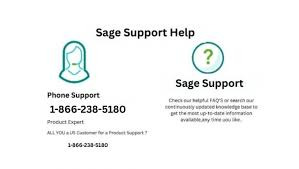When launching Sage Accpac (also called Sage 300), seeing: “Cannot access database (error = 49153)” means the application has successfully started, but failed to establish a connection to its SQL Server database. This interruption effectively halts day-to-day business tasks—like entering invoices, processing payables, or running reports—all of which depend on database connectivity
At its core, this error reveals a breakdown in the pathway between the Sage client and the SQL Server instance. The failure could stem from:
To Fix Sage Accpac Error 49153, call at 1-866-238-5180. Trained professionals can help you diagnose the root cause—whether it's a network issue, SQL configuration error, or DSN misalignment—and guide you step-by-step to restore full database connectivity and system access without delay.

- Improper DSN or ODBC configuration, especially on 64-bit systems where Sage requires a 32-bit driver.
- Network or server misconfiguration, including stopped services, disabled protocols, incorrect ports, or DNS issues.
- Blocked connectivity, due to firewall restrictions or router-level rules.
- Credential or permission issues, when the SQL login lacks rights to access the database.
Fixing this issue requires both technical understanding—and a logical, methodical approach.
Why Sage Accpac Error 49153 Happens
1. 32-bit DSN & ODBC Engineering
Sage’s architecture runs in 32-bit mode, even on 64-bit Windows. Therefore:
- Sage expects HIS DSNs to be created in the 32-bit ODBC Administrator (C:\Windows\SysWOW64\odbcad32.exe).
- If the DSN is missing—or was created under the 64-bit tool—the database remains unreachable.
A common symptom: profile switching to “Server” mode (instead of DSN), appending “32” to server name, and still failing to connect until Sage is launched ‘as Administrator’ to auto-create DSNs
2. SQL Server Service and Protocol Missteps
Sage must connect via TCP/IP. If:
- SQL Server service is stopped,
- TCP/IP protocol is disabled,
- or dynamic ports change unexpectedly,
then the communication channel closes. Named instances require the SQL Server Browser service to route connections correctly
3. DNS/Firewall Connectivity Barriers
Even when the database is online, infrastructure barriers like firewalls or DNS misresolutions can block traffic:
- Many setups restrict TCP 1433 required for SQL.
- Clients often fail to resolve the server by name but can ping the IP—suggesting DNS misconfiguration

4. Authentication & Permission Errors
Finally, the credentials used by Sage must be valid and authorized. If SQL Server is set to Windows authentication only or the login mapping is invalid, connectivity fails regardless of physical connectivity
Step-by-Step Guide to Fix Sage Accpac Error 49153

Step 1: Confirm SQL Server Service & Protocols
- On the SQL server, open Services (services.msc) and verify SQL Server (MSSQLSERVER) or named instance is Running and set to Automatic
- In SQL Server Configuration Manager under Network Configuration, ensure TCP/IP is Enabled, dynamic ports are blank, and TCP port 1433 is specified manually
- For named instances (like SQLEXPRESS), also verify SQL Server Browser is running .
- Restart services after making changes.
Step 2: Open Network Ports
Ensure TCP port 1433 is open on:
- Windows Firewall (Inbound/Outbound rules)
- Network firewalls or routers
- Group policy restrictions
Step 3: Check Server Name Resolution
From a client machine, open Command Prompt:
php-template
CopyEdit
ping SQLSERVERNAME
ping <IP_ADDRESS>
If name fails but IP works, use IP in DSN or fix DNS resolution
Step 4: Create & Verify 32-bit DSN
On each workstation:
- Run: C:\Windows\SysWOW64\odbcad32.exe
- Under System DSN, create or edit the Sage entry:
- Choose “SQL Server Native Client 11.0” (or compatible)
- Specify server (name or IP) and database
- Use SQL Authentication with working credentials
- Enable "Trust server certificate" for self-signed/TLS environments
- Test connection here; pass = confirm DSN correctness.
Step 5: Reconnect Sage via Database Setup
- Right-click Database Setup and choose Run as Administrator.
- Select Server mode (or DSN if preferred).
- Click Verify. If the DSN isn’t created automatically, this step forces it.
- Finish profile setup and exit.
- Open Sage; if 49153 reappears, note the message as it often gives deeper clues.
Step 6: Test In-App Login
Launch Sage and attempt login:
- If successful: connectivity restored.
- If error persists, review logs and error details—especially messages like “login failed” or “timeout,” which may hint at deeper issues.
Real-World Scenarios (and Solutions)
Scenario A: Fresh Server Installation
A new Sage server install commonly forgets to enable TCP/IP or open port 1433. Once services and firewall are configured correctly, the 49153 error dissipates
Scenario B: Restored Database on New Server
Migrating databases often lags behind updated connections. Clients may still point DSNs to old server names; launching Sage as Administrator rebuilds DSNs properly
Scenario C: Workstation-Specific Block
If one or a few users experience 49153, while others are fine, the problem likely lies in workstation configurations: DNS issues, wrong DSN, missing admin launch for DSN creation, or firewall blocking
Scenario D: Intermittent Drops
Some environments experience transient connectivity—indicating hardware issues like bad NICs, cables, or intermittent router failure. These require deeper network diagnostics .
Advanced Troubleshooting & Edge Cases
1. DSN Driver Conflicts
Some systems ship with ODBC Driver 18 by default, which may fail. Reverting to SQL Server Native Client 11.0 often resolves connectivity issues
2. TLS / Certificate Issues
If SQL Server enforces TLS, enabling "Trust server certificate" in the DSN helps avoid TLS negotiation errors
3. Reinstall SQL Native Client
Corrupted drivers can break SQL connectivity. Reinstalling the SQL Native Client can fix such issues
4. Registry Fixes on 64-bit Systems
In rare cases, the DSN in HKLM\SOFTWARE\Wow6432Node\ACCPAC International, Inc.\ACCPAC\... may be incorrect. Adjusting registry entries can be required—but should be done carefully
5. Network Glitches
Use tools like dbSpy or continuous ping monitoring to diagnose network-level disruptions—especially if error 49153 appears sporadically
Best Practices to Prevent Error 49153
- Enable TCP/IP and set static port 1433 in SQL Server.
- Start and auto-run SQL Browser for named instances.
- Deploy standardized 32-bit DSNs across all workstations.
- Always run Database Setup as Administrator for first-time config.
- Use SQL Authentication to simplify cross-workstation consistency.
- Keep firewalls configured to allow SQL traffic.
- Use "Trust server certificate" if TLS security is required.
- Periodically restart SQL services after patches or system updates.
- Maintain documentation of DSN settings, registry paths, and server credentials.
- Implement monitoring scripts to check connectivity and services.
When to Call Sage Support at 1‑866‑238‑5180
If after completing the above steps the 49153 error persists—especially across multiple machines—it's time to involve Sage support at 1‑866‑238‑5180. Be prepared with:
- Sage version/build & SQL Server version
- Screenshots of DSN settings and services
- Logs or error screenshots
- Network environment details (DNS, IP, firewall setup)
- Description of replication steps taken thus far
Support engineers can help with remote diagnostics, escalate to developers, or walk through advanced accident remediation.
Real-World Summary
Error 49153 is not mysterious—it always boils down to misconfiguration, network barrier, or credential failure. But if you follow this structured path:
- Ensure services and TCP/IP are configured;
- Validate name resolution and DNS/IP;
- Build correct 32‑bit DSNs;
- Launch Sage Setup as admin;
- Authenticate correctly;
then access will be restored. Remember: when in doubt, call Sage 50 support at 1‑866‑238‑5180 for timely expert help.

https://page.onstove.com/outerplane/en/view/10690918
https://support.viki.com/hc/en-us/community/posts/41710058848659-immiDiate-lIne-Sage-300-ERP-support-Number-Contact-USA-cAnAdahttps://support.viki.com/hc/en-us/community/posts/41710924621459-Sage-MAS-90-Technical-Support-Number-Sage-100-MAS90https://support.viki.com/hc/en-us/community/posts/41711242890131-inTACct-hElp-How-Do-I-Contact-Sage-Payroll-Support-Sage-payroll-Supporthttps://modrinth.com/organization/mas-90-technical-support-1-866-238-5180https://support.viki.com/hc/en-us/community/posts/41712137975955-Sage-50-PAYROLL-Support-Number-Sage50supporthttps://support.viki.com/hc/en-us/community/posts/41712620407571--Sage-50-Support-How-Do-I-Contact-Sage-50-Support-Numberhttps://support.viki.com/hc/en-us/community/posts/41713141529363-hElp-PaYroll-How-DO-I-Contact-Sage-50-Payroll-Support-Sage50-Payrollhttps://support.viki.com/hc/en-us/community/posts/41713747384467-simply-connect-How-Do-I-Contact-Sage-50-Support-Number-Sage-50-Supporthttps://support.viki.com/hc/en-us/community/posts/41714099423251-itEch-hElp-How-do-I-Contact-Sage-Support-Sage-50-Supporthttps://support.viki.com/hc/en-us/community/posts/41714496015635-Sage-50-Support-Canada-S-Ge-Quick-Help
https://pantip.com/topic/43521672
https://pantip.com/topic/43521693
https://page.onstove.com/outerplane/en/view/10678136
https://www.phonearena.com/discussions/Best-Way-to-Reach-Sage-50-Cloud-Support-by-call-cht_id153520
https://www.chess.com/blog/henryparkers938/real-help-sage-accounts-helpline-number-viliable-24-7
https://www.chess.com/blog/henryparkers938/how-do-i-contact-sage-50-payroll-support-number
